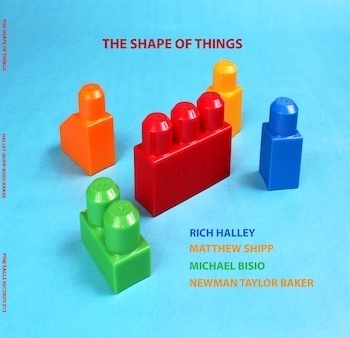https://jazzdagama.com/music/matthew-shipp-symbol-systems/
Matthew Shipp: Symbol Systems
 The notional existence of the musical theories and concepts of the music of Matthew Shipp dissolve very quickly from their abstract entities to concrete one the moment notes are sounded. Each individual one and the clusters they form in phrases and lines morph into the appearance of the footfalls of dancers in some mystical ballet, leaping into the air, pirouetting dizzily, leaping again and then seeming to fall in patterns that at first seem unruly. Soon, however, short dramatic vignettes emerge, as well as some longer narratives. No matter what we hear it is invariably something magical appears as each note is incarnated quite separate from a black dot with a definitive pulse attached to it into something quite magical that flies off the proverbial clefs charging, in turn, every other particle in the air around the room.
The notional existence of the musical theories and concepts of the music of Matthew Shipp dissolve very quickly from their abstract entities to concrete one the moment notes are sounded. Each individual one and the clusters they form in phrases and lines morph into the appearance of the footfalls of dancers in some mystical ballet, leaping into the air, pirouetting dizzily, leaping again and then seeming to fall in patterns that at first seem unruly. Soon, however, short dramatic vignettes emerge, as well as some longer narratives. No matter what we hear it is invariably something magical appears as each note is incarnated quite separate from a black dot with a definitive pulse attached to it into something quite magical that flies off the proverbial clefs charging, in turn, every other particle in the air around the room.
 Mr Shipp for the purposes of an internal discipline perhaps, assigns – or might assign – a value to each so that they have a place in his Symbol Systems. However, unleashed with the kind of power imparted to them by his supple fingers, these notes and this music becomes something living and breathing; dancers indeed, who now create the illusion of such concrete items as “Clocks” which are wound up in the pulsations of the rhythmic figures of Mr Shipp’s right hand. Elsewhere elaborate musical subterfuges ensue – on “Dance of the Blue Atoms”, for instance; or on “Bop Abyss” and “Algebraic Boogie”. Each title is seemingly a trigger which causes the hands – and fingers – of the pianist to leap and fly, and defy gravity not only with notes that ascend, light as air, as if to a rarefied realm.
Mr Shipp for the purposes of an internal discipline perhaps, assigns – or might assign – a value to each so that they have a place in his Symbol Systems. However, unleashed with the kind of power imparted to them by his supple fingers, these notes and this music becomes something living and breathing; dancers indeed, who now create the illusion of such concrete items as “Clocks” which are wound up in the pulsations of the rhythmic figures of Mr Shipp’s right hand. Elsewhere elaborate musical subterfuges ensue – on “Dance of the Blue Atoms”, for instance; or on “Bop Abyss” and “Algebraic Boogie”. Each title is seemingly a trigger which causes the hands – and fingers – of the pianist to leap and fly, and defy gravity not only with notes that ascend, light as air, as if to a rarefied realm.
Throughout the programme Mr Shipp engages the entire tonal palette of the piano creating scurrying episodes and charged silences that nestle cheek-by-jowl in their splintered melodies, fractured harmonies and bent rhythms. This is clearly the creation of a major composer whose pianism also suggests great cohesion of form and function and, above all, lyricism that sets Mr Shipp apart in the same way that it did for musicians such as Thelonious Monk and Cecil Taylor. Compression and expressivity are also equally evident in the movements of these works. As a result, the delicate melodic vignettes appear to point to a panoramic whole that, in, turn, constitutes the Symbol Systems that Mr Shipp would like us to discern in this music.
Track list – 1: Clocks; 2: Harmonic Oscillator; 3: Temperate Zone; 4: Symbol Systems; 5: The Highway; 6: Self-Regulated Motion; 7: Frame; 8: Flow of Meaning; 9: Dance of the Blue Atoms; 10: Bop Abyss; 11: Nerve Signals; 12: Algebraic Boogie; 13: The Inventor Part 1; The Inventor Part 2
Personnel – Matthew Shipp: piano
Released – 2018
Label: HatHUT (hatOLOGY 749)
Runtime – 1:00:55
 The notional existence of the musical theories and concepts of the music of Matthew Shipp dissolve very quickly from their abstract entities to concrete one the moment notes are sounded. Each individual one and the clusters they form in phrases and lines morph into the appearance of the footfalls of dancers in some mystical ballet, leaping into the air, pirouetting dizzily, leaping again and then seeming to fall in patterns that at first seem unruly. Soon, however, short dramatic vignettes emerge, as well as some longer narratives. No matter what we hear it is invariably something magical appears as each note is incarnated quite separate from a black dot with a definitive pulse attached to it into something quite magical that flies off the proverbial clefs charging, in turn, every other particle in the air around the room.
The notional existence of the musical theories and concepts of the music of Matthew Shipp dissolve very quickly from their abstract entities to concrete one the moment notes are sounded. Each individual one and the clusters they form in phrases and lines morph into the appearance of the footfalls of dancers in some mystical ballet, leaping into the air, pirouetting dizzily, leaping again and then seeming to fall in patterns that at first seem unruly. Soon, however, short dramatic vignettes emerge, as well as some longer narratives. No matter what we hear it is invariably something magical appears as each note is incarnated quite separate from a black dot with a definitive pulse attached to it into something quite magical that flies off the proverbial clefs charging, in turn, every other particle in the air around the room.
 Mr Shipp for the purposes of an internal discipline perhaps, assigns – or might assign – a value to each so that they have a place in his Symbol Systems. However, unleashed with the kind of power imparted to them by his supple fingers, these notes and this music becomes something living and breathing; dancers indeed, who now create the illusion of such concrete items as “Clocks” which are wound up in the pulsations of the rhythmic figures of Mr Shipp’s right hand. Elsewhere elaborate musical subterfuges ensue – on “Dance of the Blue Atoms”, for instance; or on “Bop Abyss” and “Algebraic Boogie”. Each title is seemingly a trigger which causes the hands – and fingers – of the pianist to leap and fly, and defy gravity not only with notes that ascend, light as air, as if to a rarefied realm.
Mr Shipp for the purposes of an internal discipline perhaps, assigns – or might assign – a value to each so that they have a place in his Symbol Systems. However, unleashed with the kind of power imparted to them by his supple fingers, these notes and this music becomes something living and breathing; dancers indeed, who now create the illusion of such concrete items as “Clocks” which are wound up in the pulsations of the rhythmic figures of Mr Shipp’s right hand. Elsewhere elaborate musical subterfuges ensue – on “Dance of the Blue Atoms”, for instance; or on “Bop Abyss” and “Algebraic Boogie”. Each title is seemingly a trigger which causes the hands – and fingers – of the pianist to leap and fly, and defy gravity not only with notes that ascend, light as air, as if to a rarefied realm.
Throughout the programme Mr Shipp engages the entire tonal palette of the piano creating scurrying episodes and charged silences that nestle cheek-by-jowl in their splintered melodies, fractured harmonies and bent rhythms. This is clearly the creation of a major composer whose pianism also suggests great cohesion of form and function and, above all, lyricism that sets Mr Shipp apart in the same way that it did for musicians such as Thelonious Monk and Cecil Taylor. Compression and expressivity are also equally evident in the movements of these works. As a result, the delicate melodic vignettes appear to point to a panoramic whole that, in, turn, constitutes the Symbol Systems that Mr Shipp would like us to discern in this music.
Track list – 1: Clocks; 2: Harmonic Oscillator; 3: Temperate Zone; 4: Symbol Systems; 5: The Highway; 6: Self-Regulated Motion; 7: Frame; 8: Flow of Meaning; 9: Dance of the Blue Atoms; 10: Bop Abyss; 11: Nerve Signals; 12: Algebraic Boogie; 13: The Inventor Part 1; The Inventor Part 2
Personnel – Matthew Shipp: piano
Released – 2018
Label: HatHUT (hatOLOGY 749)
Runtime – 1:00:55



 What these three sessions have in common is the presence of Matthew Shipp, a (usually) avant-garde pianist whose galvanic work as a soloist and leader of a trio has recently been praised in
What these three sessions have in common is the presence of Matthew Shipp, a (usually) avant-garde pianist whose galvanic work as a soloist and leader of a trio has recently been praised in  Brazilian tenor saxophonist Ivo Perelman and Shipp have a substantial history performing together. Among their many projects over the last decade are the multidisc duo sets Oneness and Efflorescence. (Perelman also made a duet record with Whit Dickey, the drummer featured here in this bassless trio.) Perelman is the Maynard Ferguson of the tenor saxophone; he can effectively play in that altissimo range. There are notes available to him that wouldn’t occur to another saxophonist, and this extended sonic territory affects his presentation, which is rarely ramrod straight. The title cut of Garden of Jewels opens with Shipp playing a soothing series of chords. Then Perelman enters as breathily as Ben Webster playing a ballad. He seems to be musing: his initial upward-thrusting phrase sounds dramatic, but it is followed by a tumbling subsidence. I hesitate to call what Shipp and Perelman do together a dialogue. It is more like they are tripping down the same yellow brick trail. They are performing in parallel with the utmost sensitivity. Almost three minutes into “Tourmaline,” after a restless opening, the two emit simultaneous staccato notes, at different pitches. They are improvising, but they are so well attuned to each other that the interplay comes off as an example of miraculous conjunction. I should also credit drummer Dickey for his myriad colors and willingness to let the two melodic instruments suggest his moves. “Onyx” begins as a kind of hushed duet between Shipp and Dickey, with Perelman sitting out. Shipp plays a phrase, stops, and waits for Dickey’s spare commentary. Then the pianist goes on. When Perelman enters, it is in the altissimo range. I am not sure what meaning Perelman attaches to the gems commemorated in his song titles: to me the music shines like gold.
Brazilian tenor saxophonist Ivo Perelman and Shipp have a substantial history performing together. Among their many projects over the last decade are the multidisc duo sets Oneness and Efflorescence. (Perelman also made a duet record with Whit Dickey, the drummer featured here in this bassless trio.) Perelman is the Maynard Ferguson of the tenor saxophone; he can effectively play in that altissimo range. There are notes available to him that wouldn’t occur to another saxophonist, and this extended sonic territory affects his presentation, which is rarely ramrod straight. The title cut of Garden of Jewels opens with Shipp playing a soothing series of chords. Then Perelman enters as breathily as Ben Webster playing a ballad. He seems to be musing: his initial upward-thrusting phrase sounds dramatic, but it is followed by a tumbling subsidence. I hesitate to call what Shipp and Perelman do together a dialogue. It is more like they are tripping down the same yellow brick trail. They are performing in parallel with the utmost sensitivity. Almost three minutes into “Tourmaline,” after a restless opening, the two emit simultaneous staccato notes, at different pitches. They are improvising, but they are so well attuned to each other that the interplay comes off as an example of miraculous conjunction. I should also credit drummer Dickey for his myriad colors and willingness to let the two melodic instruments suggest his moves. “Onyx” begins as a kind of hushed duet between Shipp and Dickey, with Perelman sitting out. Shipp plays a phrase, stops, and waits for Dickey’s spare commentary. Then the pianist goes on. When Perelman enters, it is in the altissimo range. I am not sure what meaning Perelman attaches to the gems commemorated in his song titles: to me the music shines like gold. Mat Walerian, who plays clarinets and flute as well as tenor, proclaims himself to be a mostly self-taught instrumentalist — though he admits he has studied with Shipp, with whom he collaborates. Besides having the longest album title I can remember, his two-disc set Every Dog Has Its Day But It Doesn’t Matter Because Fat Cat Is Getting Fatter is notable because of its superstar lineup, with the always estimable William Parker on bass, Shipp on piano, and Hamid Drake on percussion. They call themselves the Okuden Quartet.
Mat Walerian, who plays clarinets and flute as well as tenor, proclaims himself to be a mostly self-taught instrumentalist — though he admits he has studied with Shipp, with whom he collaborates. Besides having the longest album title I can remember, his two-disc set Every Dog Has Its Day But It Doesn’t Matter Because Fat Cat Is Getting Fatter is notable because of its superstar lineup, with the always estimable William Parker on bass, Shipp on piano, and Hamid Drake on percussion. They call themselves the Okuden Quartet.

